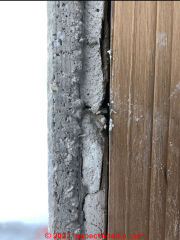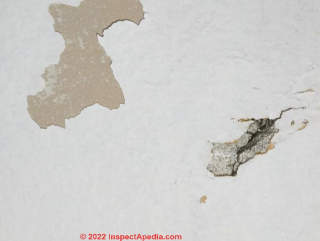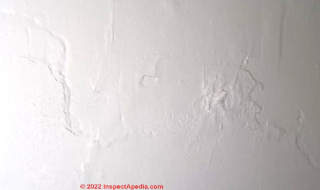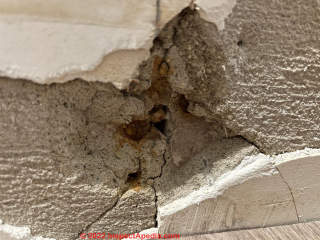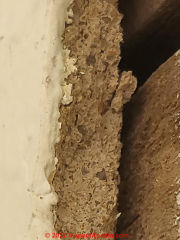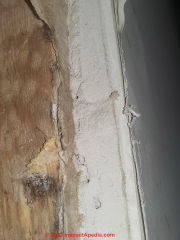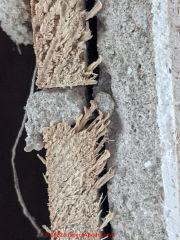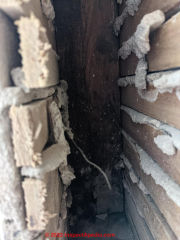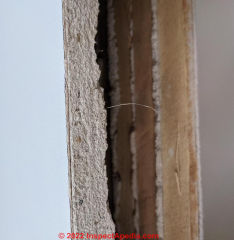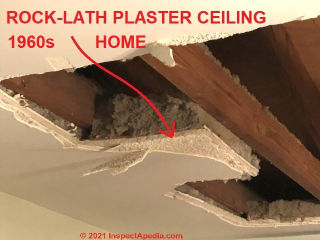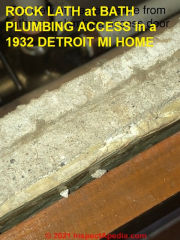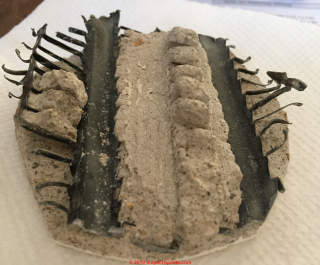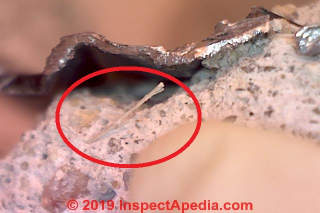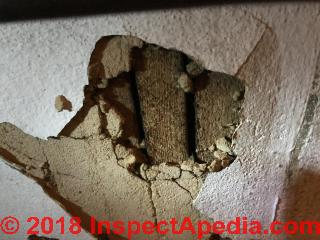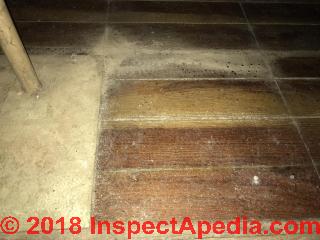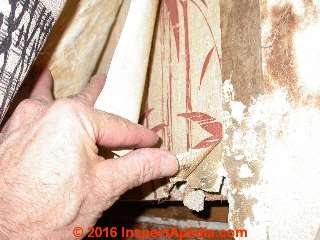 FAQs: Asbestos Content in Plaster
FAQs: Asbestos Content in Plaster
Q&A on asbestos in older plaster walls & ceilings
- POST a QUESTION or COMMENT about the level of asbestos found in plaster
Questions & answers on the asbestos content of plaster used in buildings on walls and ceilings.
This article series explains where & when asbestos is likely to be found in plaster used on building walls & ceilings.
InspectAPedia tolerates no conflicts of interest. We have no relationship with advertisers, products, or services discussed at this website.
- Daniel Friedman, Publisher/Editor/Author - See WHO ARE WE?
FAQs on the Use of Asbestos in Plaster
These questions & answers about the presence of asbestos in plaster in buildings were posted originally
at ASBESTOS in PLASTER - be sure to read that article.
[Click to enlarge any image]
On 2023-03-12 by InspectApedia Editor
@Mark,
Thanks for taking the time to send us your update.
On 2023-03-08 by Mark
@InspectApedia Editor ,
Thanks for your reply. Just got the test results: negative!
On 2023-03-02 by InspectApedia Editor - damp wipe and HEPA vac all surfaces or get dust sample tested
@Mark,
We're flying blind here as we can't see and know so little about your home, but if there is dust remaining from your work done 8 years ago, or if you're worried that there may be such harmful dust, you'd damp wipe and HEPA vac all surfaces, from the work area on outwards to include nearby rooms that might have gotten some of that dust.
OR you could collect some representative settled dust samples such as from trim over a window or door - surfaces probably not cleaned recently, to see if an environmental test lab finds notable levels of asbestos in the dust.
On 2023-02-28 by Mark
I live in a house near Baltimore built in 1954. I did a lot of work on the house about 8 years ago during which I removed some plaster-over-rocklath walls. Recently I've become aware that plaster and/or rocklath often contained asbestos, which makes me feel absolutely sick.
I've just taken a sample of the wall to send out for testing (I'll post results when I get them), my question is: what do I do if it's positive? I remember trying to avoid creating dust by minimizing sawing when removing the plaster, but I'm sure I just shop-vac'd up any dust I did create.
How long might my house have had unsafe levels of airborne asbestos (or could it still be contaminated)?
On 2022-12-06 by InspectApedia (Editor) - baseboard trim on plaster walls minimizes asbestos risk
@Alex,
If the bottom edges of your plaster walls are covered by baseboard trim there's no reasonable chance of a meaningful or even detectable asbestos hazard from that source. You shouldn't need to caulk anything.
On 2022-12-06 by Alex
I renovated my house 1950’s house in southern Ontario. Removing baseboards adding new doors and casings etc. I did wear a p100 mask while removing the plaster some walls were removed but some plaster walls were left.
Wondering if I should add caulking at the bottom of all the baseboards and any gaps around electrical fixtures where particles could make there way into my airspace. The plaster did look friable behind the baseboards
On 2022-09-30 by InspectApedia-911 (mod)
@Derrel,
Our best information on that is above on this page. Please take a look and let me know what questions remain.
On 2022-09-29 by Derrel
@InspectApedia-911, I was mainly asking about the gray plaster that held it on and if they put asbestos in it
On 2022-09-29 by InspectApedia-911 (mod)
@Derrel,
Asbestos is possible but uncommon in ceramic tile.
Asbestos was common in tile mastics.
If any of your building products were made in the US before 1986 then there's some possibility that there was asbestos.
None of the comment nor the information that you have at hand would allow a useful speculation about the potential hazard level to which you have been exposed.
On 2022-09-29 by Derrel
@InspectApedia , I am not able to get a picture but I'm in tucson az
On 2022-09-28 by InspectApedia (mod)
@Derrel,
With just the few words of your message, we couldn't give a definitive or informed answer. You could try posting a photo to give us some added insight.
Where are you located - country, city?
Ceramic floor and wall tile produced in North America would not be expected to contain asbestos. However you may find asbestos in some tile grouts and thinset tile mastics. Read more at
ASBESTOS CONTENT IN CERAMIC FLOOR OR WALL TILE
https://inspectapedia.com/hazmat/Ceramic_Tile_Asbestos_Content.php
Let us know if you have additional questions.
On 2022-09-28 by Derrel
I removed a bathrub and tile today from 1953 and I only wore a paint mask. I want to know if there were abestos in it or not is there a way to tell? It was tile with a grayish brown plaster.
On 2022-09-23 by InspectApedia-911 (mod)
@Kristy,
Friable means that a material can easily be made into a very fine powder that would be airborne simply by rubbing the material between your forefinger and thumb.
Cementious materials including plaster are not friable.
Furthermore as I've said several times now the total quantity of material exposed by a 1 inch small gouge or crack and plaster is simply insignificant.
Finally you have no reason to know that your plaster actually contained any asbestos.
On 2022-09-23 by Kristy
@InspectApedia-911, I was worried since my hangers have been scraping against the exposed part and getting on my clothes for three years. I'm not too sure how friable asbestos plaster is and how big the risk is. Never thought twice about the possibility until now.
I guess I'm looking for a theoretical answer? I truly appreciate your help. This has been a very insightful website!
On 2022-09-22 by InspectApedia-911 (mod)
@Kristy,
One can't assess an asbestos hazard by text but I read nothing in your post that would have led me to toss clothing away.
On 2022-09-22 by Kristy
@InspectApedia (Editor), If it has asbestos, should I be concerned about my clothes being contaminated? I threw out a couple shirts that had white on them just incase. I recently thought of the possibility of asbestos in it. Would the risk have be high?
On 2022-09-22 by InspectApedia (Editor)
@Kristy,
That looks like plaster or plasterboard perhaps with a layer of wallpaper and more layers of paint.
Very tiny area of damage - easily repaired by removing loose paint and coating with joint compound or plaster patch compound.
On 2022-09-22 by Kristy
What wall material is this? It's part of my closet. Apartment in a house that was built in 1900, renovation listed in 1950, in Maine. My clothes have been rubbing on it for a few years. The exposed part looks like crumbly concrete. Hoping its not asbestos.
On 2022-09-10 by InspectApedia-911 (mod)
@Michael,
That's a GREAT question, thank you.
I've been guilty of ducking the really hard question about HEPA vacuums.
A long way back my friend Jeff May (Cambridge MA) tested a bunch of HEPA-rated vacuum cleaners to see just how well they really worked to remove fine particles.
What Jeff found was just what we both had thought: MANY HEPA-rated vacuum cleaners of various designs were so leaky that they actually increased the level of airborne particles while running, even though they also were vacuuming up and keeping some dust and debris.
At the time Jeff found that the most expensive Miele vacuum was among the least leaky - and was NOT an industrial nor shop-vac grade in vacuuming capacity.
But that was decades ago.
I suspect that today we'd find the same range of performance.
So lacking an independent, trusted testing lab report on HEPA Vacuum effectiveness and leakiness, I'd look for a model that's rated as not leaky.
I suspect (but don't know for fact) that ANY normal shop vac that's retrofitted with a HEPA filter inside the vacuum cleaner is rather leaky.
A web search for "HEPA RATED VACUUM CLEANER REVIEWS" yields a blizzard of articles on "best HEPA vacuum" but
Watch out: I would read those reviews with great care to see just what the reviewers considered important, what tests were performed, and with what expertise.
Then take a look at
ASTM F3150-18 - Standard Specification for HEPA Filtration System Performance of Residential and Commercial Vacuum Cleaners
1. Scope
1.1 This specification defines industry acceptable test methods and approaches for evaluating residential and commercial vacuum cleaner filtration systems to HEPA filtration performance levels.
1.2 This specification defines the minimum filtration efficiency requirements for achieving HEPA performance for filtration systems of residential and commercial vacuum cleaners.
1.3 This specification applies only to residential and commercial vacuum cleaning products that are used in non-critical applications. Non-critical applications refers to applications not requiring the removal of hazardous dust as defined per IEC 60335-2-69.
1.4 This standard does not purport to address all of the safety concerns, if any, associated with its use. It is the responsibility of the user of this standard to establish appropriate safety, health, and environmental practices and determine the applicability of regulatory limitations prior to use.
available from ASTM
On 2022-09-10 by Michael
I have seen you recommend HEPA-vacuuming when cleaning up dust, rather than using an ordinary shop vac. Is a HEPA vacuum a specific model, or can I use my ordinary shop vac with the HEPA filter installed?
Thanks in advance for your help, and for your hard work on this site!
On 2022-07-25 by InspectApedia-911 (mod)
@Jake Connolley,
Doesn't sound too worrisome. To be thorough, clean up, damp wipe, HEPA vacuum.
On 2022-07-25 by Jake Connolley
Hi, I bought a home built in 1963 in a residential neighborhood. We had some water damage and a company came out to cut the bottom of the wall in our bathroom to place their fans for drying.
The woman on the phone asked me when the house was built in order to see if the company should be looking for asbestos. We got worried. The home inspection says our walls are plaster.
The walls and ceiling’s in our house are flat and do not have any texture. We are concerned that there might be asbestos in the plaster walls and ceiling? When they cut the walls the walls were wet and they stated that very minimal dust is released when the walls are wet
On 2022-07-08 by InspectApedia-911 (mod)
@Nathan,
Thank you very much for following up and taking time to post the test results of the layers of plaster in your home and reporting that asbestos was not found.
That will be helpful to other readers.
On 2022-07-08 by Nathan
@InspectApedia-911, I decided to get the layers tested. Three layers were tested, the upper layer of white plaster, the rock lath wall, and the fibrous material behind the rock lath. No asbestos was detected in any of those layers. Thanks for your thoughts!
On 2022-07-06 by InspectApedia-911 (mod)
@Nathan,
As long as we are faced with a very small area such as the one in your photo it may make more sense to treat the debris as presumed to contain asbestos rather than to pay the lab fee to have it tested. Instead you could spend that same cost on damp wiping and HEPS vacuuming and then a simple plaster patch or repair compound spread over the hole.
But arguing with myself just to give another point of view, it might be worth sending out a full cross section of the plaster for an asbestos test. That will tell you whether you need to take extra precautions in any future modifications, cutting sign or drilling into walls of ceilings etc.
Let me know what you think and what you prefer.
On 2022-07-06 by Nathan
Hi there, appreciate the blog and you getting back to individual readers. We have a house built in Central Massachusetts in the early 1960s. We recently removed baseboards and the plaster behind crumbled in a few spots. Looks like there may be some rock lath underneath.
Don't have a great cross section, but photo attached is up close. For size reference you can see a rusty old nail head. I'm mostly concerned with that pinkish gray layer, which looks like that "brown coat" layer from TD's photo. Any thoughts would be much appreciated. Thank you!
On 2022-04-08 by Inspectapedia Com Moderator - more information and review of data is important
@MC,
It's a perfectly understandable question to ask what's the probability that my plaster walls contain asbestos.
I'm sorry to say we have no probability data that would permit any absolute answer. Guesses that are so speculative will probably be simply wrong.
The best I can suggest is to look through the information on the page above, reviewing the data that we have found by researching the asbestos-in- plaster question.
The bottom line is that if you avoid demolition or other activities that chop, grind, saw or sand or otherwise make a dusty mess of your plaster walls, it's not likely that there is a detectable asbestos hazard nor other dust coming from that source.
On 2022-04-07 by MC
My home was built in 1927 and has plaster walls. They are not ornate, just flat plaster. I am attaching a photo of the edge of a cut made before we lived here to accommodate a vent. How likely is it that we have asbestos in the walls?
On 2022-03-27 by Inspectapedia Com Moderator - undamaged plaster walls, with or without asbestos, do not pose risk
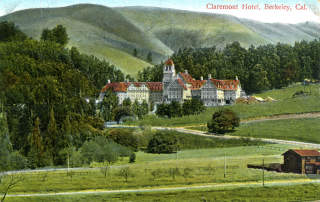 @Jerry power,
@Jerry power,
Please oh please take a look at the article above where we discuss the answer to your question. Of course we won't have any specific information about the plaster in the Claremont, but if you're describing the Claremont in Berkeley, it was built in 1915 - old enough that a variety of plaster formulas may have been used over its lifetime.
Just walking by or working around plaster walls and ceilings that are undamaged and intact has a zero chance of causing an asbestos-related illness or even a plaster-related illness.
It's not likely that asbestos dust caused your sore-throat. More likely is a recent exposure to COVID or to a guest carrying a respiratory illness, OR if you've been doing demolition of plaster walls, plaster dust itself is highly irritating.
On 2022-03-27 by Jerry power
I'm working at The Claremont Hotel I'm curious if the plaster has asbestos in it but I have a sore throat
On 2021-12-07 by Inspectapedia Com Moderator - need more information in order to determine asbestos or not
@Katie D,
Apologies, I wish I could give a reliable number on the risk of asbestos in plaster, like 53.8 % probability that the old plaster contains asbestos, but the truth is that's impossible.
Just consider that we know nothing about the building that's the subject of your question: its location, construction, size, use, modifications, nor where in the building the plaster is located. For example one might be more-likely to find asbestos used in a building where extra fire-resistance was needed, say over and around heating equipment.
Please take a look at the article above where we address this question, and do let me know if that leaves you with suggestions.
On 2021-12-07 by Katie D
1930 plaster on wire/ metal lathe. What is chance of ASBESTOS in this plaster?
On 2021-09-20 by inspectapedia.com.moderator
@Miriam,
From your photo I see what looks like plaster which has been partly painted over.
With no other information at all about your building, Age, Country, location, history, or other images, our best advice remains what you will find above on this page. Please take a look and let me know if any questions remain.
On 2021-09-19 by Miriam
I make changes in my bathroom and we cut the gypsum off the wall. I found this white material which is crumbling. what it can be asbestos
On 2021-09-05 by inspectapedia.com.moderator - no asbestos found in this plaster on wood lath sample tested
@Kyle, good news, and thank you for taking time to follow-up; your photos and discussion and test results - no asbestos in this plaster - will help other readers.
On 2021-09-05 by Kyle
@inspectapedia.com.moderator,
Thanks again for your info on this. I'm pleased to say there was no asbestos found in the sample I had tested.
On 2021-09-01 by inspectapedia.com.moderator
@Kyle,
That's a great cross-section photo of classic plaster on wood lath. Thank you.
Yes, about the horsehair, the way we have most-often been able to see it in plaster, outside of forensic lab (where we can look by microscope) is in attics and stairwells where only the plaster rough coat was applied and then painted; often we could then see horsehair right on the plaster surface.
Once the top coat or skim coat of finish plaster is applied you'll only see it on the back plaster ears through the lath or in the lab or sometimes at where the plaster is broken rather than cut neatly.
On 2021-09-01 by Kyle
@inspectapedia.com.moderator,
Thanks for getting back to me. Hopefully these pictures are decent, I've cut a hole in the wall (using a mask for most of it) to fit sliding doors. You can't really see lots of hair due to the way it's been cut but there are some in the pics. Thanks
On 2021-08-31 by inspectapedia.com.moderator
@Kyle,
Thanks, that's a great question, and one that I'm embarrassed to say, despite decades of work on this topic, I cannot answer:
I don't have any confidence in any number or percentage chance that 1930s plaster in the UK contained asbestos, though my gut feel is that it wasn't in most plasters.
Keep in mind that plaster dust is itself harmful on several scores: alkaline, and fine particulates;
But the worry may be the greater health hazard for you than the plaster, especially if you're not doing demolition or creating a dusty mess. If your plaster is intact it's not shedding particles at any meaningful level
I'd like to see photos (one per comment) of the front and wall cavity or attic side of our plaster walls or ceilings, and of course do share your lab result with us as that will help other U.K. readers.
On 2021-08-31 by Kyle
Hi, I live in a house built late 1930's in the UK. The wall plaster has hair in it but my concern is if it contains asbestos. Is there a percentage of how likely a house built around this time would contain asbestos? We have had a lot of building work done, by myself and builders on different occasions.
There was lots of dust as walls/ceilings were removed and can't recall the builders taking any precautions or being concerned. I've sent a sample away to be test but can't seem to stop thinking about this.
Thanks
Kyle
On 2021-07-27 by Aaron B
@inspectapedia.com.moderator, Thank you!
On 2021-07-27 by inspectapedia.com.moderator - steps to minimize exposure even with limited cuts
@Aaron B,
Yes those are limited cuts.
Keep in mind that how you make a cut in plaster or drywall and how you control dust make a lot of difference in dust exposure in any event.
Even the difference between using a fine-tooth circular hole cutter at low speed versus a coarse tooth circular hole cutter at high speed is significant.
Your original question I wasn't sure whether we were talking about plaster or drywall / Simpson board. It's easier to make Cuts in drywall with virtually no dust than it is in plaster. But in both cases you can minimize dust, wear protective gear, and keep things in perspective.
On 2021-07-25 by Aaron B
Thank you for the reply, that's very helpful to know. Is something like pot light insertion or let's say 3-4-inch(ish) holes for the purpose fishing electrical wires considered a limited cut? Thank you again, this website is a blessing
On 2021-07-25 by (mod)
@Aaron B,
I suspect the cost of testing is greater than the cost of treating the material as presumed to contain asbestos when you're making small, limited cuts; keep dust down, wet surfaces, damp wipe, HEPA vac.
On 2021-07-25 by Aaron B
For a house built between 1950-1955, should we assume that there is asbestos in the ceiling/walls? Would you recommend testing walls/ceilings if we intend on putting in pot lights (fairly big holes?), making holes in the wall for electrical work, and maybe breaking down a wall? Thank you
On 2021-07-11 by inspectapedia.com.moderator (mod)
@Renee,
Our best information that answers your question is in the article above on this page. Please take a look. If that's unclear or leaves you with questions don't hesitate to ask.
On 2021-07-11 by Renee
Would asbestos be present in plaster in a home that was built in 1921?
On 2021-06-13 by inspectapedia.com.moderator (mod) - old house renovators got hives
@Patricia,
While nobody can give reliable, comprehensive home safety advice from a brief e-text, and thus while I always worry that there are more-immediate hazards (falling down the stairs, fire, etc) in a building than the ones that come to your attention, it is possible to give a few suggestions:
There may be asbestos in old buildings in any of several locations such as plastery, drywall, flooring, pipe insulation.
I have not found any research citing hives as specifically asbestos-related.
But in any old house, the dust caused by demolition and renovation is potentially hazardous as well as a respiratory irritant.
Old house dust, especially if you're demolishing plaster or cleaning up old dusty dirty areas, may include
- lead
- pesticides or other chemicals
- insect fragments and mite fecals and rodent hair or fecals all of which are allergens and potentially more harmful
- silica dust
Start by asking your doctor for advice, including the question of the role that home renovations might play in your medical complaints, as well as the risks of such work for anyone who has cancer and thus, undergoing treatment, may be immune-compromised.
And meanwhile,
- use damp wiping and HEPA- vacuuming (NOT an ordinary shop vac or household vac) to clean up dust and debris from areas in which you are living, starting with the rooms in which you spend the most time
- you can certainly use any low VOC paint with brushes and rollers to paint, or have-painted, ceilings, walls, trim, in those same rooms or in rooms where the ceiling or wall surfaces seem to be shedding material
- Unless there is loose plaster at risk of falling on you, I'd avoid any demolition; often, as you can read in this article series, even loose plaster can be secured to the lath behind it using large plaster washers and screws.
- do not assume that your plaster is the only, or even the most- serious hazard in your home.
- take note of the home's leak history - there could be mold contamination (also something you'd discuss with your doc)
- be sure you have working CO and smoke detectors properly installed, located, tested
On 2021-06-13 by Patricia
I am trying to renovate our old house, supposedly built around the late 1930s or 1940s. Recently my husband and I have been having hives, coughing, generally feeling bad. The temperature outside has been very hot, high 90s. I am wondering if there is a connection with the heat ( NO air conditioning) and the plaster itself.
Does it contain asbestos? We were not told of any asbestos in the house when we bought it. What can I do to quickly treat and cover the walls with paint?
I am extremely worried. My husband has cancer. His hives, constant itching is just terrible. PLEASE ADVISE. Thank you, thank you.
On 2021-05-31 by inspectapedia.com.moderator (mod) - test dust to determine source and type
@Katherine,
If it is not damaged or disturbed, plaster does not shed any detectable level of harmful dust.
However if the plaster is loose, falling, or damaged by renovations or other work on the building, its dust can be a harmful respiratory irritant, whether or not it also contains asbestos.
If by visual inspection you don't see cracked, loose, falling, or cut-into, damaged, disturbed plaster, then that's not the source of your dust complaint.
See DUST SAMPLING PROCEDURE
for a procedure for collecting representative samples of indoor dust (inexpensive and easy) that you can then send to any environmental test lab.
Ask the test lab to tell you if there is a significant presence of unusual particles in the dust sample, and/or high levels of harmful particles like mold, dustmite fecals, allergens, asbestos, etc.
On 2021-05-30 1 by Katherine
I live in an 84 year old home that has plaster walls. There seems to be quite a lot of 'Heavy" dust all the time and myself and my daughter, have a cough from it. Can old plaster 'Shed" and cause respritory problems? Someone told me, re-painting can help. What do you suggest? We have lived here for 5 years and it seems to get worse all the time.
On 2021-04-24 - by (mod) -
@Rebecca, Thank you so much.We've worked hard on this material for decades, so I'm really grateful when a reader finds it useful and trustworthy.
We also welcome your photos, questions, criticism or suggestions.
Working together makes us smarter.
On 2021-04-24 by Rebecca
@danjoefriedman, thank you for tending to this very serious topic that affects 100s of 1000s of poeple in the US I'm sure. For us, your keeping up this blog is truly kind! Thank you!
On 2021-03-14 by (mod) - hazard of anthrax exposure from old plaster that contains horsehair?
@colm dowdall,
Thank you for the interesting question that I might re-phrase as "Is there a meaningful hazard of anthrax exposure from old plaster that contains horsehair?"
I am compelled to add that at least in the U.K. there are a number of websites and sources who warn about hazards of anthrax exposure in old or historic buildings. Be sure to review the source of those assertions and watch for conflicting interests.
The WHO, in comparison, can be expected to be without the Other People's Money motive nor profit motive in giving advice about Anthrax hazards.
In the UK, Bacillus anthracis is subject to COSHH regulations (Control of Substances Hazardous to Health). Those regulations are more general than the more narrow question of known hazards of exposure to horsehair in plaster.
see
GUIDELINES FOR THE SURVEILLANCE AND CONTROL OF ANTHRAX IN HUMAN AND ANIMALS. 3rd edition. [PDF] WHO/EMC/ZDI/98.6 PCB Turnbull
Centre for Applied Microbiology and Research Porton Down, Salisbury, Wiltshire SP4 0JG, UK original source:
http://www.who.int/emc
download also at inspectapedia.com/hazmat/Anthrax-Control-WHO_EMC_ZDI_98.6.pdf
Excerpt: There is, in fact, no conflict between the statements and evidence given in 4.2.1 and 4.2.2 that
humans are fairly resistant to fatal anthrax infection and the possible aggressive use of anthrax
spores.
The worst case natural contamination in the environment is found at the carcass sites of animals that have died of anthrax.
In a study in Namibia of 106 such sites, the highest contamination level found was just over 1 million anthrax spores per gram of soil, but 79% had less than 1000 per gram and 25% less than 10 per gram (Lindeque and Turnbull, 1994).
Levels in other types of inadvertently contaminated environments (soils at tannery sites, horsehair plaster, etc.) rarely exceed a few units or tens of spores per gram (Turnbull, 1996).
Natural
environmental exposure to infectious doses in the normal course of human life and endeavour
is, therefore, a fairly unlikely event. - Op. Cit. p. 13
Because horsehair was used in old plaster in many countries including the U.K. and North America and because animal hair can in principle carry anthrax, there has grown up an industry of testing such materials for anthrax before demolition or remodeling.
If you read our article on OTHER PEOPLE'S MONEY inspectapedia.com/home_inspection/Other_Peoples_Money.php
you'll see why consultants asked a question like yours will often spend your money to reduce their risk by saying "YES DO TEST for ANTHRAX"
But I'm still looking for even one scholarly research article that reports even one case of someone contracting anthrax from 100 year old building plaster.
If you have any such authoritative sources please let me know.
On 2021-03-13 by colm dowdall - test my original plaster cast cornice for asbestos?
Should I test my original plaster cast cornice for asbestos and ceiling lath plaster for anthrax before any work begins to modernise my 1905 house
Question: is the material shown in this plumbing access asbestos?
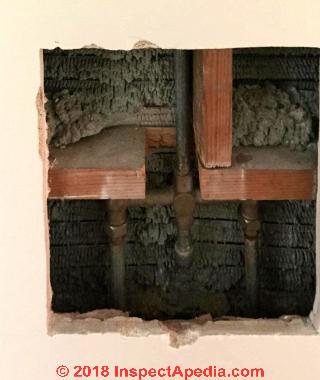 2018/05/15 shelby.hudson655321 said:
2018/05/15 shelby.hudson655321 said:
We are getting ready to rent (have put down a deposit) on a house built in 1955.
There is this easily accessible panel on the wall opposite the bathroom for access to the plumbing for the tub. Is or could this be asbestos? We have a 2 year old daughter and don't want to take any chances!
This question and reply were posted originally
at INSULATION IDENTIFICATION GUIDE
Reply:
Shelby
Your photo shows cement or plaster extruding through expanded metal lath, no doubt providing the wall onto which bathroom tile was affixed.
While some plaster in older homes might (rarely) contain asbestos, this is not a friable material. Even if the plaster contains asbestos you would have to grind, saw, or chop the material to create dust and thus to create a measurable hazard.
In sum, undisturbed, this plaster in the plumbing access is not a child hazard.
See details about this wall construction and its materials
Question: was asbestos used in plaster casts?
2018/09/08 srevesz said:
Was asbestos used in the material used for casts for a broken bone?
This Q&A about the use of asbestos in bone casts or orthopedic casts were posted originally
Reply: yes asbestos was used in a wide range of plaster casting including orthopedics
S Reves
Yes, asbestos was used in some plaster cast and plaster mold applications, both directly in forms of asbestos fibres and also in the form of vermiculite, some of which contains asbestos.
There are some patent disclosures and research citing use of asbestos in products applied to splints and casts for broken bones, and possibly also in some denture casts, including those listed above
at PLASTER DUST EXPOSURE HEALTH HAZARDS
Question: do 1967 "Rock Lath" plaster walls or ceilings contain asbestos?
Note: Original, as emailed photos from the reader and home discussed below have been removed at the reader's request - the reader's close-up photos showed edges of what appeared to be either drywall or rock lath based plaster at electrical box openings such as at a wall plug receptacle and at a light switch - Ed.
Shown here from two different homes, we have provided examples of rock lath, courtesy of and with special thank-you to other InspectApedia.com readers K.K. and C.M.
Anonymous asked:
All of [my photos in my email to you] are photos from a 1967 house we are considering purchasing.
Do you think any of the photos might have asbestos in them?
Some of walls are plaster. Thank you for your input. Ceilings are plaster. Anonymous by private mail 2021/06/22
Moderator reply:
No one can say with confidence whether or not plaster, rock lath, or gypsum board drywall have or don't have asbestos based on the photographs that you emailed to us.
We studied with care all of your pictures and could see what appears to be the edge of rock lath and gypsum board at an electrical receptacle, a switch, and at other wall or ceiling openings.
Plasterboard, drywall, and also joint compound used on wall and ceiling surfaces and at joints in the 1960s and up into 1986 might indeed contain asbestos.
If it is not damaged or disturbed, plaster or drywall do not shed any detectable level of harmful dust, asbestos or otherwise.
Asbestos is safe and legal to leave alone in buildings, in fact safer than trying to remove-it, as long as it is left undamaged and in good condition. - US EPA [paraphrased]
However if the plaster is loose, falling, or damaged, or will-be damaged by renovations or other work on the building, its dust can be a harmful respiratory irritant, whether or not it also contains asbestos.
Watch out: If you are facing such demolition or renovation work it would make sense to either treat these ceilings and walls as if they contain asbestos, to have representative samples tested.
As it will be helpful to other readers, and as its publication may prompt other readers to offer a helpful suggestion, I will include a redacted (to respect your privacy) version of this discussion in our article above.
Also see ASBESTOS in DRYWALL
Also see PLASTER DUST EXPOSURE HEALTH HAZARDS
On 2021-02-24 by (mod) - even asbestos-free, dust from plaster and drywall, particularly at high levels, remains a respiratory hazard.
Right, Jesse, it's not likely that those plaster walls contained asbestos but one can't be absolutely certain without having the material tested.
As I point out in these articles,
Watch out: even asbestos-free, dust from plaster and drywall, particularly at high levels, remains a respiratory hazard.
On 2021-02-24 by Jesse D.
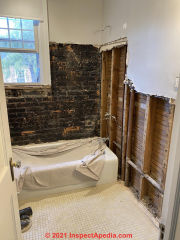 Thanks. So, to be clear, since this plaster was in the bathroom, not decorative or fire resistant-needed, it’s not likely (though not entirely ruled out) to contain asbestos?
Thanks. So, to be clear, since this plaster was in the bathroom, not decorative or fire resistant-needed, it’s not likely (though not entirely ruled out) to contain asbestos?
On 2021-02-24 - by (mod) -
@Jesse D., I see plaster on expanded metal lath;
The asbestos question for plaster is discussed in better-detail on the page above than I should attempt to repeat here; please take a look and don't hesitate to ask if any of that is unclear or incomplete.
No one can say from a photo alone whether or not asbestos was used in plaster, but you should be sure to read what we know about that question, above.
On 2021-02-24 by Jesse D.
Doing a bathroom reno and wondering what you think is underneath this wall on the right. It looks like plaster, affixed to a wooden lath, and then a metal mesh over that.
House was built in 1939, do you think this could contain asbestos? J
On 2021-02-12 by (mod) - Chrysotile asbestos confirmed in tile mastic adhesive
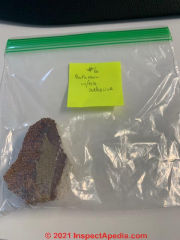 thanks Ben; that may be an asbestos-containing asphalt-based mastic adhesive.
thanks Ben; that may be an asbestos-containing asphalt-based mastic adhesive.
See also
ASBESTOS-CONTAINING MASTIC DANGEROUS?
On 2021-02-11 by Ben - 5-10% Chrysotile 95% Matrix
I tested a number of plaster over wallboard panels in my house and none were found to contain asbestos.
However, we did find a small amount in this tile adhesive layer.
Tan Homogeneous 5-10% Chrysotile 95% Matrix
On 2020-12-26 by (mod) - asbestos hazard test for dust from plaster wall cut-out work
Timothy
At this point since the majority of the cutting and cleanup have been done what is left for you to do is either collect a representative sample of settled dust to test for asbestos or representative samples of the wall that was cut out to test for asbestos.
If there is found to be a significant asbestos level in either of those materials then you may want to do some additional cleaning such as damp wiping and HEPA vacuuming
On 2020-12-26 by Timothy Franks
The homeowner from whom I rent cut out a large portion of the kitchen wall. I'm scared he exposed my cousin and me to asbestos given that there was dust following the work, that he vacuumed it with a non-HEPA vacuum, and that there was an air conditioner that we used over the summer after the work was completed which likely trapped dust and aerosolized it.
House was built in the late 1800s and I believe that the wall was renovated in the early-to-mid-1950s.

On 2020-10-07 - by (mod) -
Brad
Asbestos was used but not commonly in old plaster; beyond that we can't say without a lab test.
On 2020-10-07 by Brad
Newly opened wall, old plaster. Older plaster wall with a metal lathing behind it, large straw or hay looking fibers in it the plaster. Is it likely not to contain asbestos because it has the straw fibers? Photo attached
On 2020-03-09 by (mod) - Possible asbestos in plaster on expanded metal lath in Ontario
Tomor
As usual modus in the article above it's possible that your ceiling plaster contains asbestos.
For such limited damage of single hole drilled to pass some cables and assuming that it's otherwise in good condition, it's reasonable that you would clean up the dust and you could stop there. Use damp wiping and HEPA vacuuming.
On 2020-03-09 by Tomor Sodnompil
Hi, here is a pic of a plaster wall with metal lath behind ( that I drilled through in order to pass cables through for a wall mounted TV). The picture is a close up of the hole, it is about 1 inch in height.
The metal lath isnt visible in the pic, and at this point Im too afraid to disturb it further. After reading around Im concerned that the plaster has asbestos content. I live in an old concrete building in Hamilton, Ontario but I am not sure when it was built, my best guess 1970s or 80s.
Do you think I should be worried? I am thinking of bringing someone in to get the material tested.
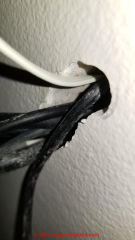
Question: asbestos in expanded metal lath plaster?
We just found a ceiling in our 1847 house which is unlike the other plaster-and-lath ceilings; it is an expanded metal lath, hard cement or concrete, on wood lath.
Photo below. I do not see anything fibrous that would indicate that it contains significant amounts of asbestos. Any opinions?
I would like to open some holes for ducts (using standard mask etc. protection). Thanks in advance!
Reply:
Expanded metal lath and plaster will be a newer material than older wood-lath.
You would not be able to literally "see" asbestos in cement or plaster even if it is present as the individual fibers are too small. Asbestos in your plaster would be unusual but not impossible; you'd either treat the material as presumed to contain asbestos (dust control, etc) or have a sample tested.
Certainly because silica dust is also hazardous to breathe or to get into your eyes, you will want to use basic dust control measures and appropriate protective gear when cutting, drilling, or demolishing any plaster walls or ceilings.
To be extra careful
see ASBESTOS REMOVAL, WETTING GUIDE
Watch out: even if the plaster does not contain asbestos, the silica dust that is created during sawing or grinding or demolition is a respirator hazard, particularly at higher levels.
Watch out: also, that metal lath will give a nasty cut if you don't wear heavy gloves when handling it.
Reader follow-up: fibers visible in plaster
Thanks. I include a ~30x photo which shows one visible fiber. We will send off the sample for testing, but any further observations welcome. I'll report back what I learn.
Moderator reply:
DS that fiber looks like a fragment of broom straw or wood or a wooden twig; you would not see asbestos in a thick twig-like particle like that. That won't be asbestos.
Some of our photos of asbestos are at ASBESTOS UNDER the MICROSCOPE
Reader follow-up: this plaster did not contain asbestos
2020/01/13 David Shoemaker said:
I'm happy to report there was no asbestos found in the sample. thanks again for the exchange --
On 2020-09-16 - by (mod) -
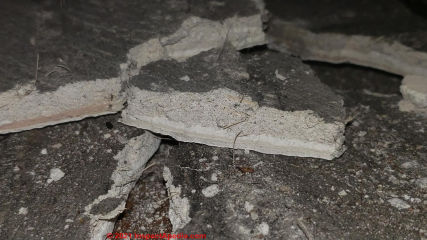 In your photo (shown above) that plaster debris looks like traditional 3 coat plaster; please review the asbestos in plaster discussion found at the topic home:
In your photo (shown above) that plaster debris looks like traditional 3 coat plaster; please review the asbestos in plaster discussion found at the topic home:
ASBESTOS in PLASTER where we provide data on the use of asbestos in plaster, at https://inspectapedia.com/hazmat/Asbestos-in-Plaster.php
On 2020-09-15 by Dawn
this is my fallen livingroom ceiling. Does it look like asbestos?
On 2020-09-03 by (mod) - hazards from leak through ceiling onto bedding and mattress
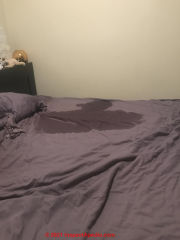 If a mattress has been wet from plumbing leaks, particularly drain leaks, it's likely to be contaminated beyond economic repair.
If a mattress has been wet from plumbing leaks, particularly drain leaks, it's likely to be contaminated beyond economic repair.
Steam cleaning won't reach deeply-enough into a mattess to make it sanitary if it's been contaminated by leakage; the concern, from your photo, is the wetting.
If you're concerned about asbestos in the bedding, you would certainly wash the bed clothes if they haven't already been cleaned.
On 2020-09-03 by Erika
My old apartment built in 1900 probably remodeled a bunch since had a ceiling leak.
I didn’t think anything of it until I started reading about asbestos as a new homeowner. Did I have a past exposure to asbestos.
I still have the same bed that the ceiling leaked on should I get rid of it ?
On 2020-08-28 by Samantha
We have asbestos Chrysotile in all our bedrooms. The lab report says the risk is very low. The plaster is behind woodchip paper which I am keen to remove. Is this a really dangerous thing to do? Thanks!
On 2019-07-13 by (mod) - safest to leave asbestos-suspect materials in place
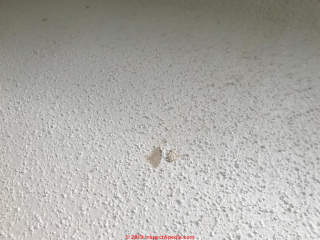 Anon:
Anon:
In general it's safest to leave asbestos-suspect materials in place, covering over the floor, wall, or ceiling material.
It's not as if it's radioactive; covered = safe, as it's un-disturbed and protected from disturbance.
On 2019-07-13 by Anonymous - is asbestos dangerous if covered by wood?
It is the dangerous when you covered it with wood. Because were covering it with but we did no know about asbestos until wr saw it on tv? What kind of ceiling is?
On 2019-07-13 by (mod) -
yes - see CECI's ceiling photo just above.
On 2019-07-12 by CECI
Is it possible that this may contain asbestos. - see ceiling photo above.
Reader follow-up: tested drywall for asbestos - traces of asbestos found in plaster base under drywall
 Thanks again for your advice regarding asbestos. I ended up having a sample tested, there were multiple layers as you can see in the piece that I sampled for testing.
Thanks again for your advice regarding asbestos. I ended up having a sample tested, there were multiple layers as you can see in the piece that I sampled for testing.
The conclusion was that the second layer in from the outside has trace amounts of asbestos. Way less that 1% the lab tech told me. They are sending the full report through to me later today.
I attached a photo. The side with my thumb is the inside. The thick gypsum part had no asbestos, and the outer (I presume skim coat) has no asbestos. But popcorny looking part is where the trace amount was found.
As it is less than 1% and the two pieces that I'm removing are 3ft x 7ft, am I am looking for advice regarding best practices to remove it?
As it is a trace amount less that 1% should I just go for it and have no concern? Should I still use extreme care? The stuff does make a pretty dusty mess, so that is my concern,
I live in a neighborhood of 40's houses, and I'm pretty sure everyone around here knocks entire walls down with the stuff falling on their faces, so I may be overthinking this! Although we did lose a family friend a while back to mesothelioma, so that probably is what is causing my anxiety.
Any advice would be greatly appreciated.
Sean Sullivan
Reply:
Sean, to me that photo - shown above - looks like a layer of drywall bonded over a layer of plaster skim coat over a layer of plaster base coat or of cementious plasterboard. It's the older plasterboard or possibly a skim coat that may contain asbestos, depending on when it was applied.
To be extra careful Sean,
see ASBESTOS REMOVAL, WETTING GUIDE
On 2019-05-27 0 by (mod) -
As we said in response to your question by email
Unfortunately with no more information than the age of the rock lath or gypsum board that you're removing, if you have to make a Dusty demolition mess then you need to either treat the material as presumed to contain asbestos, or to have representative samples tested.
On 2019-05-27 0 by Sean Sullivan
Hi, I have a 1940"s house in Denver. I'm about to demo some drywall to widen a closet door. Looks like rock lath, about 3/4 in thick and very crumbly when compromised. Should I be worried about asbestos? Attached are photos of an edge. Have some exposed in back of a bathroom that is button hole, but not sure if this is the same.
On 2018-03-23 by Anonymous
We agree. It'd be easy to inspect your air handler.
On 2018-03-22 by Vickie
I’ve read that some plaster did have asbestos added, & I’m hoping with our 1908 house this has none. I was concerned that my air return was sucking in this dust and contaminating us, especially given the crystalline silica push now.
Question: is the material shown in this plumbing access photo asbestos?
 2018/05/15 shelby.hudson655321 said:
2018/05/15 shelby.hudson655321 said:
We are getting ready to rent (have put down a deposit) on a house built in 1955.
There is this easily accessible panel on the wall opposite the bathroom for access to the plumbing for the tub. Is or could this be asbestos? We have a 2 year old daughter and don't want to take any chances!
This question and reply were posted originally
at INSULATION IDENTIFICATION GUIDE
Reply:
Shelby
Your photo shows cement or plaster extruding through expanded metal lath, no doubt providing the wall onto which bathroom tile was affixed.
While some plaster in older homes might (rarely) contain asbestos, this is not a friable material. Even if the plaster contains asbestos you would have to grind, saw, or chop the material to create dust and thus to create a measurable hazard.
In sum, undisturbed, this plaster in the plumbing access is not a child hazard.
See details about this wall construction and its materials at PLASTER LATH, METAL
On 2018-03-23 by Anonymous - inspect the HVAC air handler & ducts for plaster dust contamiantion
We agree. It'd be easy to inspect your air handler. In any event if the air handler or ductwork are dust-contaminated it'd make sense to have them cleaned.
Yes plaster was used in some asbestos mixes as we discuss in detail at ASBESTOS in PLASTER
To be accurate, plaster is not asbestos. Some plaster mixes contained asbestos however.
On 2018-03-22 by Vickie - some plaster contained asbestos
I’ve read that some plaster did have asbestos added, & I’m hoping with our 1908 house this has none. I was concerned that my air return was sucking in this dust and contaminating us, especially given the crystalline silica push now.
I used a niosh filter mask and wet wiped things, even spraying some with soapy water before using a hepa vac to remove the plaster chunks and sand.
The plaster is just crumbling into sand. I pray it isn’t asbestos. I have 2 young boys that I worry a lot about.
On 2018-03-21 by (mod) -
It would be foolish of me to pretend that I could inspect her assess the environmental dangers in your home by a brief a text in a few photographs. Please remember what I sent you previously.
Just picking up a few chunks of plaster to drop into the trash is not likely to contaminate you, your house, your family - nor would it alone create a measurable airborne asbestos hazard even if the material contained asbestos.
As you probably know plaster dust is alkaline and respiratory irritant. But a fundamental concept with any exposure is that the dose makes the poison.
On 2018-03-21 21 by Vickie - photos of old plaster in a 1908 home - this may contain asbestos?
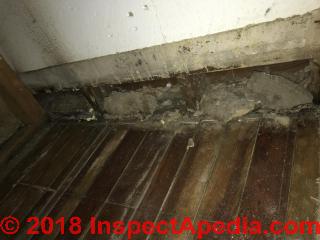 So do you think we are at risk of exposure to asbestos or crystalline silica? I’m so ready to be out of this old House.
So do you think we are at risk of exposure to asbestos or crystalline silica? I’m so ready to be out of this old House.
On 2018-03-21 by (mod) -
I would damp wipe, then HEPA VAC for cleanup. Be sure to use the proper HEPA vacuum cleaner (one that doesn't leak) in order to avoid making asbestos-containing dust even more airborne and more dangerous. Some experts, fearing such aeration, recommend simply damp wiping surfaces.
1908 house. Upon further inspection plaster and a sand like substance are falling off around the furnace and in the air handler area.
Now I am terrified my family has been breathing in asbestos and silica for years unknowingly because of a failing plaster job.
Can I hepa vac this stuff up or wet mop? Advice is greatly appreciated.
This is a circa 1908 house. After further inspection, I have found that plaster has fallen out in the area/box surrounding/encasing the air return.
There are chunks of it falling and a sand like substance on the floor. Now I’m in panic mode worrying that our entire house has been sprayed with asbestos and silica. What should I do? I have a true HEPA vac that I bought for another issue. Is it safe to suck up this debris or should I wet mop. Thanks for any help because I am terrified.
On 2018-03-21 by (mod) - Just picking up a few chunks of plaster to drop into the trash is not likely to contaminate you at any significant level
Vickie
Just picking up a few chunks of plaster to drop into the trash is not likely to contaminate you, your house, your family - nor would it alone create a measurable airborne asbestos hazard even if the material contained asbestos. On the other hand, being terrified is itself more-likely a greater health hazard.
Plaster with hair in it is probably quite old - often horse hair was used. I'd like to see some sharp photos of the mateiral - use the Picture Frame icon next to the comment button.
Making a dusty mess, blowing plaster dust about in a home, would be a more serious respiratory concern, even without asbestos.
On 2018-03-21 by Vickie - I recently picked up several chunks of plaster that is falling off
I recently picked up several chunks of plaster that is falling off of the wall next to our furnace. There is lath, a dark brown layer with dark hair in it, and then a thin, white layer on top of it.
I didnt use any precautions and now am freaking out the possibility that it contains asbestos, which has contaminated me and possibly my entire house and family.
There is crumbled pieces of plaster still there that I have not removed. It is powdery now. Should I be freaking out or is this probably not asbestos containing plaster?
...
Continue reading at ASBESTOS in PLASTER where we provide data on the use of asbestos in plaster, or select a topic from the closely-related articles below, or see the complete ARTICLE INDEX.
Or see these
Recommended articles
- ASBESTOS in DRYWALL - the use of asbestos in gypsum board drywall products and in joint compound
- ASBESTOS IDENTIFICATION IN BUILDINGS
- ASBESTOS PRODUCING COMPANIES & TRUSTS
- ASBESTOS CEMENT PRODUCTS
- PLASTER INGREDIENTS, MIX, PROPERTIES
- PLASTER TYPES & METHODS in BUILDINGS - widespread use of asbestos in plaster and plaster products
Suggested citation for this web page
ASBESTOS in PLASTER FAQs at InspectApedia.com - online encyclopedia of building & environmental inspection, testing, diagnosis, repair, & problem prevention advice.
Or see this
INDEX to RELATED ARTICLES: ARTICLE INDEX to ASBESTOS HAZARDS
Or use the SEARCH BOX found below to Ask a Question or Search InspectApedia
Ask a Question or Search InspectApedia
Try the search box just below, or if you prefer, post a question or comment in the Comments box below and we will respond promptly.
Search the InspectApedia website
Note: appearance of your Comment below may be delayed: if your comment contains an image, photograph, web link, or text that looks to the software as if it might be a web link, your posting will appear after it has been approved by a moderator. Apologies for the delay.
Only one image can be added per comment but you can post as many comments, and therefore images, as you like.
You will not receive a notification when a response to your question has been posted.
Please bookmark this page to make it easy for you to check back for our response.
IF above you see "Comment Form is loading comments..." then COMMENT BOX - countable.ca / bawkbox.com IS NOT WORKING.
In any case you are welcome to send an email directly to us at InspectApedia.com at editor@inspectApedia.com
We'll reply to you directly. Please help us help you by noting, in your email, the URL of the InspectApedia page where you wanted to comment.
Citations & References
In addition to any citations in the article above, a full list is available on request.
- In addition to citations & references found in this article, see the research citations given at the end of the related articles found at our suggested
CONTINUE READING or RECOMMENDED ARTICLES.
- Carson, Dunlop & Associates Ltd., 120 Carlton Street Suite 407, Toronto ON M5A 4K2. Tel: (416) 964-9415 1-800-268-7070 Email: info@carsondunlop.com. Alan Carson is a past president of ASHI, the American Society of Home Inspectors.
Thanks to Alan Carson and Bob Dunlop, for permission for InspectAPedia to use text excerpts from The HOME REFERENCE BOOK - the Encyclopedia of Homes and to use illustrations from The ILLUSTRATED HOME .
Carson Dunlop Associates provides extensive home inspection education and report writing material. In gratitude we provide links to tsome Carson Dunlop Associates products and services.


